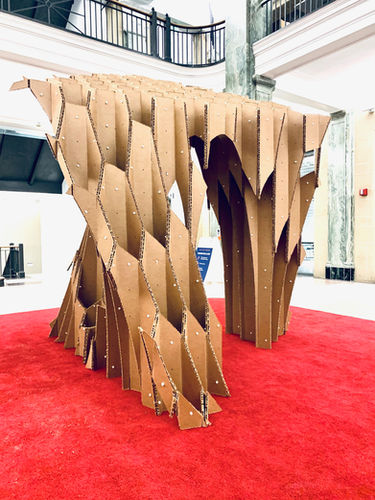top of page
Honeycomb Folds
Research
2020
The Honeycomb Folds pavilion is part of an ongoing series and investigation on folding and origami fabrication techniques in concrete. The fabrication of the cardboard structure replicates a robotic concrete prefabrication system that we, in collaboration with Cemex Global R&D, are working on at Autodesk Buildspace in Boston.
Due to the pandemic, the group had to postpone efforts there to fabricate the concrete elements. In the meantime, we are moving forward with testing of fabrication and assembly in cardboard.
The broader framework of this project is part of our ongoing R&D of novel architectural forms and elements through the use of Cemex's Resilia concrete mix in combination with advanced folding techniques. Cemex’s Resilia mix provides the necessary flexibility during the fabrication process and the needed ultra-high-strength and ductility when cured.
The fabrication of the cardboard study was made possible through a Faculty Research Fund from the School of Architecture. The cardboard was used to test techniques at full-scale while the team was waiting to get back into Autodesk Buildspace. The cardboard is useful in that it is testing the folding geometry, the sequence from digital form making to fabrication output, as well as the assembly sequence of the entire pavilion. The full-scale model is especially useful to study the connection between the elements and the system of placing the individual components in space before being executed with the final concrete material. The mock-up also provided an opportunity to study possible window frame geometries and screen perforation patterns. The elements consist of a series of interlocking vertical elements of varying heights. The pieces are made from corrugated cardboard that resembles the thickness of the concrete to scale (approx. ½ inch). The 4x8 feet cardboard sheets were CNC cut and folded together by hand to create the individual elements. Vinyl fasteners were used for the connection between the pieces.
This mock-up would not have been possible without the support of our hardworking and dedicated RIs, Michael Aiardo and Timothy Tamulonis, and, of course, Cemex Global R+D’s ongoing financial, technical and intellectual support.
Research Partner: CEMEX Global R&D
bottom of page










